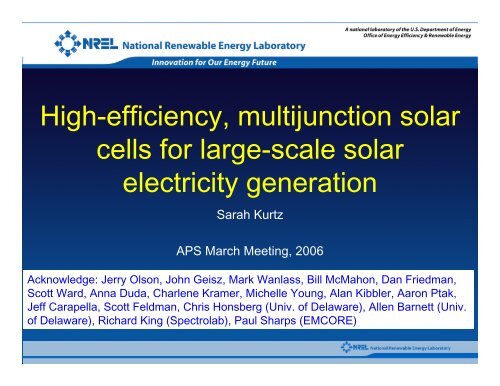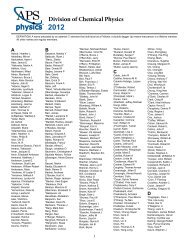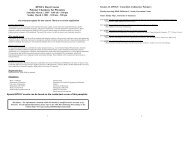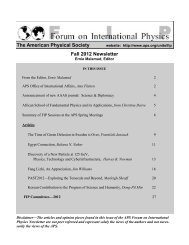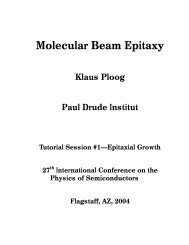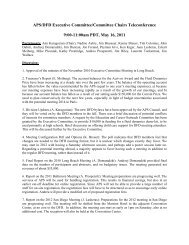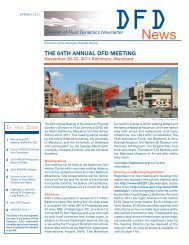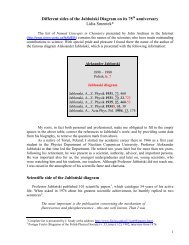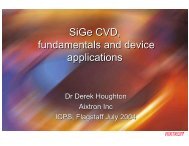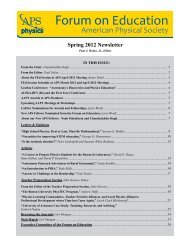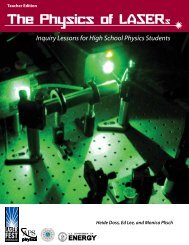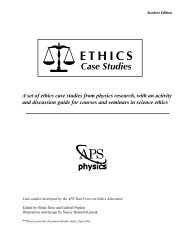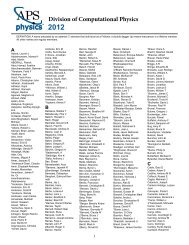High-efficiency, multijunction solar cells for large-scale solar ...
High-efficiency, multijunction solar cells for large-scale solar ...
High-efficiency, multijunction solar cells for large-scale solar ...
Create successful ePaper yourself
Turn your PDF publications into a flip-book with our unique Google optimized e-Paper software.
<strong>High</strong>-<strong>efficiency</strong>, <strong>multijunction</strong> <strong>solar</strong><br />
<strong>cells</strong> <strong>for</strong> <strong>large</strong>-<strong>scale</strong> <strong>solar</strong><br />
electricity generation<br />
Sarah Kurtz<br />
APS March Meeting, 2006<br />
Acknowledge: Jerry Olson, John Geisz, Mark Wanlass, Bill McMahon, Dan Friedman,<br />
Scott Ward, Anna Duda, Charlene Kramer, Michelle Young, Alan Kibbler, Aaron Ptak,<br />
Jeff Carapella, Scott Feldman, Chris Honsberg (Univ. of Delaware), Allen Barnett (Univ.<br />
of Delaware), Richard King (Spectrolab), Paul Sharps (EMCORE)
Outline<br />
• Motivation - <strong>High</strong> <strong>efficiency</strong> adds value<br />
• The essence of high <strong>efficiency</strong><br />
– Choice of materials & quality of materials<br />
– Success so far - 39%<br />
• Material quality<br />
– Avoid defects causing non-radiative recombination<br />
• <strong>High</strong>-<strong>efficiency</strong> <strong>cells</strong> <strong>for</strong> the future<br />
– Limited only by our creativity to combine high-quality<br />
materials<br />
• The promise of concentrator systems
Photovoltaic industry is growing<br />
Worldwide PV shipments (MW)<br />
1500<br />
1000<br />
500<br />
0<br />
Data from the<br />
Prometheus Institute<br />
1999 2000 2001 2002 2003 2004 2005<br />
Year<br />
~$10 Billion/yr<br />
Growth would be even faster if cost is reduced and availability increased
To reduce cost and increase availability:<br />
Front<br />
Back<br />
reduce semiconductor material<br />
Solar cell<br />
A higher <strong>efficiency</strong> cell<br />
increases the value of<br />
the rest of the system<br />
Thin film<br />
Goal: Cost dominated by<br />
Balance of system<br />
Concentrator
Detailed balance: Elegant approach<br />
<strong>for</strong> estimating <strong>efficiency</strong> limit<br />
Balances the radiative transfer between the sun (black body)<br />
and a <strong>solar</strong> cell (black body that absorbs Ephoton >Egap), then<br />
uses a diode equation to create the current-voltage curve.<br />
Shockley-Queisser limit: 31% (one sun); 41% (~46,200 suns)
Solar spectrum<br />
5x10 17<br />
4<br />
3<br />
2<br />
1<br />
0<br />
0<br />
Band gap<br />
of 0.75 eV<br />
1<br />
Why <strong>multijunction</strong>?<br />
Power = Current X Voltage<br />
2<br />
Photon energy (eV)<br />
<strong>High</strong> current,<br />
but low voltage<br />
Excess energy lost to heat<br />
3<br />
4<br />
Solar spectrum<br />
5x10 17<br />
4<br />
3<br />
2<br />
1<br />
0<br />
0<br />
1<br />
2<br />
Photon energy (eV)<br />
Band gap<br />
of 2.5 eV<br />
<strong>High</strong> voltage,<br />
but low current<br />
Subbandgap light is lost<br />
<strong>High</strong>est <strong>efficiency</strong>: Absorb each color of light with a<br />
material that has a band gap equal to the photon energy<br />
3<br />
4
Detailed balance <strong>for</strong> multiple junctions<br />
Detailed Balance Efficiency (%)<br />
100<br />
80<br />
60<br />
40<br />
20<br />
0<br />
Maximum Concentration<br />
2<br />
One sun<br />
4<br />
6<br />
Concentration limit<br />
One sun limit<br />
Number of junctions or absorption processes<br />
Depends on Egap, <strong>solar</strong> concentration, & spectrum.<br />
Assumes ideal materials<br />
8<br />
10<br />
Marti & Araujo<br />
1996 Solar Energy<br />
Materials and Solar<br />
Cells 43 p. 203
Achieved efficiencies - depend<br />
Efficiency (%)<br />
80<br />
60<br />
40<br />
20<br />
more on material quality<br />
0<br />
1<br />
Detailed balance<br />
One sun<br />
Polycrystalline<br />
2<br />
Detailed balance<br />
Maximum concentration<br />
3<br />
Number of junctions<br />
Single-crystal<br />
(concentration)<br />
Single-crystal<br />
Amorphous<br />
4<br />
5
Efficiency (%)<br />
40<br />
36<br />
32<br />
28<br />
24<br />
20<br />
16<br />
12<br />
8<br />
4<br />
0<br />
1975<br />
Multijunction Concentrators<br />
Three-junction (2-terminal,<br />
monolithic)<br />
Two-junction (2-terminal,<br />
monolithic)<br />
Crystalline Si Cells<br />
Single crystal<br />
Multicrystalline<br />
Thick Si Film<br />
Thin Film Technologies<br />
Cu(In,Ga)Se2 CdTe<br />
Amorphous Si:H (stabilized)<br />
Nano-, micro-, poly- Si<br />
Multijunction polycrystalline<br />
Emerging PV<br />
Dye <strong>cells</strong><br />
Organic <strong>cells</strong><br />
(various technologies)<br />
1980<br />
Best Research-Cell Efficiencies<br />
1985<br />
1990<br />
Year<br />
1995<br />
2000<br />
2005
Multijunction <strong>cells</strong> use multiple<br />
materials to match the <strong>solar</strong> spectrum<br />
4 5 6 7 8 9<br />
1<br />
Energy (eV)<br />
2 3 4<br />
GaInP 1.9 eV<br />
GaInAs 1.4 eV<br />
Ge 0.7 eV<br />
Efficiency record = 39%<br />
p<br />
2005 R. King, et al, 20th European<br />
PVSEC
Efficiency (%)<br />
40<br />
30<br />
20<br />
10<br />
0<br />
Success of GaInP/GaAs/Ge cell<br />
NREL invention<br />
of GaInP/GaAs<br />
<strong>solar</strong> cell<br />
1985<br />
commercial 3-junction concentrator<br />
production of<br />
tandem<br />
1990<br />
tandempowered<br />
satellite<br />
flown<br />
1995<br />
Year<br />
production<br />
levels reach<br />
300 kW/yr<br />
2000<br />
2005<br />
39%!<br />
This very successful space cell is<br />
currently being engineered into systems<br />
<strong>for</strong> terrestrial use<br />
QuickTime and a<br />
TIFF (LZW) decompressor<br />
are needed to see this picture.<br />
Mars Rover powered by<br />
<strong>multijunction</strong> <strong>cells</strong>
Solar cell - diode model<br />
light<br />
n-type material<br />
Deplet ion<br />
width<br />
p-type<br />
material<br />
Fermi<br />
level<br />
Collect photocarriers at built-in field be<strong>for</strong>e they recombine.
Types of recombination<br />
• Auger<br />
• Radiative<br />
• Non-radiative - tied to material quality
Ec<br />
Ev<br />
Non-radiative recombination<br />
generates heat instead of electricity<br />
Heat<br />
Trap<br />
Heat<br />
Shockley - Read - Hall recombination<br />
• Large numbers of phonons are required<br />
when ΔE is <strong>large</strong> -- probability of transition<br />
decreases exponentially with ΔE<br />
• Trap fills and empties; Fermi level is critical
Defects - problems and solutions<br />
• Defects that cause states near the middle of<br />
the gap are the biggest problem<br />
• These tend to be crystallographic defects<br />
(dislocations, surfaces, grain boundaries)<br />
– use single crystal<br />
• “Perfect” single-crystal material has defects<br />
only at edges<br />
– Terminate crystal with a material that <strong>for</strong>ms bonds<br />
to avoid unpaired electrons<br />
– Build in a field to repel minority carriers
Solar cell schematic to show<br />
light<br />
surface passivation<br />
Passivat ing<br />
window<br />
n-type p-type<br />
Deplet ion<br />
width<br />
Fermi<br />
level<br />
Passivat ing<br />
back-surface field
Summary about high <strong>efficiency</strong><br />
• <strong>High</strong> <strong>efficiency</strong> cell makes rest of system<br />
more valuable<br />
• Minimize non-radiative recombination<br />
– Use single crystal<br />
– “Get rid of” surfaces with passivating layers<br />
• With these ground rules, how do we combine<br />
materials? - Lots of research opportunities
Many available materials<br />
Bandgap (eV)<br />
2.4<br />
2.0<br />
1.6<br />
1.2<br />
0.8<br />
0.4<br />
0.0<br />
5.4<br />
AlP<br />
GaP<br />
Si<br />
AlAs<br />
GaAs<br />
Ge<br />
InP<br />
5.6 5.8 6.0<br />
Lattice Constant (Å)<br />
By making alloys, all band gaps can be achieved<br />
AlSb<br />
GaSb<br />
InAs<br />
6.2<br />
6.4<br />
InSb
Ways to make a single-crystal alloy<br />
Ordered Random Quantum<br />
wells<br />
Quantum<br />
dots<br />
Challenges: • avoid <strong>for</strong>ming defects while controlling structure<br />
• collect photocarriers
Strain is distributed uni<strong>for</strong>mly<br />
Mobility is determined by band structure<br />
Need driving <strong>for</strong>ce <strong>for</strong> ordering, or growth<br />
is impossible<br />
Relatively easy to grow<br />
Alloy scattering is usually small; mobility<br />
is decreased slightly<br />
Collection of photocarriers usually<br />
requires a built-in electric field<br />
Growth is typically more complex,<br />
especially to avoid defects and to<br />
control sizes of quantum structures
Strain is distributed uni<strong>for</strong>mly<br />
Mobility is determined by band structure<br />
Need driving <strong>for</strong>ce <strong>for</strong> ordering, or growth<br />
is impossible<br />
Relatively easy to grow<br />
Alloy scattering is usually small; mobility<br />
is decreased slightly<br />
Collection of photocarriers usually<br />
requires a built-in electric field<br />
Growth is typically more complex,<br />
especially to avoid defects and to<br />
control sizes of quantum structures
GaInP/GaAs/Ge cell is lattice<br />
Bandgap (eV)<br />
2.8<br />
2.4<br />
2.0<br />
1.6<br />
1.2<br />
0.8<br />
0.4<br />
0.0<br />
5.4<br />
AlP<br />
GaP<br />
Ga 0.5In 0.5P<br />
Si<br />
GaAs<br />
Ge<br />
matched<br />
5.6<br />
AlAs<br />
GaAs<br />
Ge<br />
5.8<br />
InP<br />
6.0<br />
InAs<br />
Lattice Constant (Å)<br />
GaSb<br />
AlSb<br />
6.2<br />
6.4<br />
InSb
Bandgap (eV)<br />
2.8<br />
2.4<br />
2.0<br />
1.6<br />
1.2<br />
0.8<br />
0.4<br />
0.0<br />
New lattice matched alloys<br />
5.4<br />
AlP<br />
GaP<br />
AlAs<br />
Ga0.5In0.5P Si<br />
GaAs<br />
GaInAsN<br />
Ge<br />
5.6<br />
GaAs<br />
Ge<br />
5.8<br />
Lattice matched approach is<br />
easiest to implement, but is<br />
limited in material combinations<br />
InP<br />
Lattice Constant (Å)<br />
6.0<br />
InAs<br />
GaSb<br />
Open-circuit voltage (V)<br />
1.0<br />
0.9<br />
0.8<br />
0.7<br />
0.6<br />
0.5<br />
1.15<br />
GaInNAs is candidate<br />
<strong>for</strong> 1-eV material, but<br />
does not give ideal<br />
per<strong>for</strong>mance<br />
GaAs<br />
GaNAs<br />
GaInNAs<br />
n-on-p p-on-n<br />
1.20<br />
1.25<br />
1.30<br />
Bandgap (eV)<br />
GaAs<br />
1.35<br />
Ga(In)NAs<br />
1.40
Larger<br />
lattice constant<br />
Smaller<br />
lattice constant<br />
Method <strong>for</strong> growing<br />
mismatched alloys<br />
Step<br />
grade<br />
confines<br />
defects<br />
SiGe (majority-carrier)<br />
devices are now common,<br />
but mismatched epitaxial<br />
<strong>solar</strong> <strong>cells</strong> are in R&D stage<br />
220DF<br />
GaAsP<br />
step grade<br />
1 µm<br />
XTEM<br />
GaAs 0.7 P0.3 0.3<br />
GaP
Bandgap (eV)<br />
<strong>High</strong>-<strong>efficiency</strong> mismatched cell<br />
2.8<br />
2.4<br />
2.0<br />
1.6<br />
1.2<br />
0.8<br />
0.4<br />
0.0<br />
5.4<br />
AlP<br />
GaP<br />
5.6<br />
AlAs<br />
Ga GaAs<br />
0.9In0.1As Si<br />
Ga 0.4In 0.6P<br />
Ge<br />
Ge<br />
5.8<br />
InP<br />
Lattice Constant (Å)<br />
GaSb<br />
InAs<br />
GaInP top cell<br />
GaInAs middle cell<br />
Grade<br />
Ge bottom cell<br />
and substrate<br />
1.8 eV<br />
1.3 eV<br />
0.7 eV<br />
6.0<br />
Metal<br />
38.8% @ 240 suns<br />
R. King, et al 2005, 20th European PVSEC
Bandgap (eV)<br />
2.8<br />
2.4<br />
2.0<br />
1.6<br />
1.2<br />
0.8<br />
0.4<br />
0.0<br />
Inverted mismatched cell<br />
AlP<br />
GaP<br />
AlAs<br />
Ga0.5In0.5P 5.4<br />
Si<br />
GaAs<br />
5.6<br />
GaAs<br />
Ga 0.3In 0.7As<br />
Ge<br />
5.8<br />
InP<br />
Lattice Constant (Å)<br />
6.0<br />
InAs<br />
GaSb<br />
Substrate removed<br />
after growth<br />
GaAs substrate<br />
GaInP top cell<br />
GaAs middle cell<br />
Grade<br />
GaInAs bottom cell<br />
1.9 eV<br />
1.4 eV<br />
1.0 eV<br />
Metal<br />
37.9% @ 10 suns<br />
Mark Wanlass, et al 2005
Mechanical stacks<br />
GaAs cell<br />
GaSb cell<br />
32.6% <strong>efficiency</strong> @ 100 suns<br />
1990 L. Fraas, et al 21st PVSC, p. 190<br />
4-terminals<br />
Easier to achieve high <strong>efficiency</strong>, but more difficult in<br />
a system because of heat sinking and 4-terminals<br />
Wafer bonding provides pathway to monolithic structure<br />
A. Fontcuberta I Morral, et al, Appl. Phys. Lett. 83, p. 5413 (2003)
Summary<br />
• Photovoltaic industry is growing > 40%/year<br />
• <strong>High</strong> <strong>efficiency</strong> <strong>cells</strong> may help the <strong>solar</strong> industry<br />
grow even faster<br />
• Detailed balance provides upper bound (>60%)<br />
<strong>for</strong> efficiencies, assuming ideal materials<br />
• Single-crystal <strong>solar</strong> <strong>cells</strong> have achieved the<br />
highest efficiencies: 39%<br />
• <strong>High</strong>er efficiencies will be achieved when ways<br />
are found to integrate materials while retaining<br />
high crystal quality
Flying high with high <strong>efficiency</strong><br />
Cells from Mars rover<br />
may soon provide<br />
QuickTime and a<br />
TIFF (LZW) decompressor<br />
are needed to see this picture.<br />
QuickTime and a<br />
TIFF (LZW) decompressor<br />
needed to see this picture.<br />
electricity on earth<br />
QuickTime and a<br />
TIFF (LZW) decompressor<br />
are needed to see this picture.<br />
<strong>High</strong> <strong>efficiency</strong>, low cost,<br />
ideal <strong>for</strong> <strong>large</strong> systems


